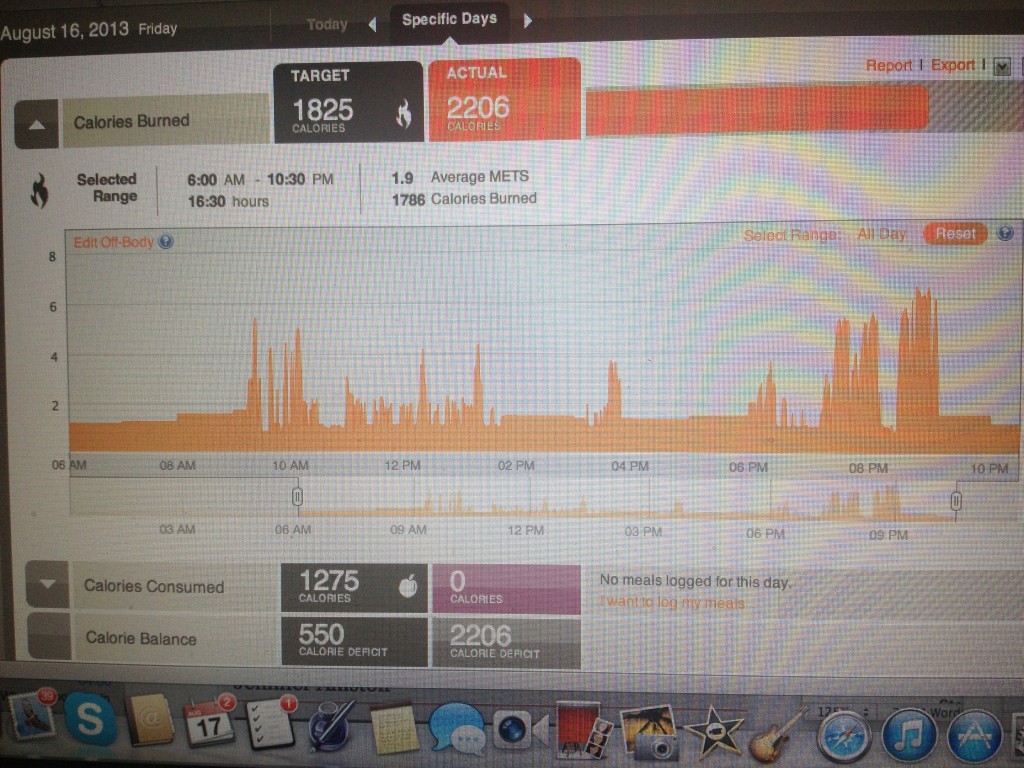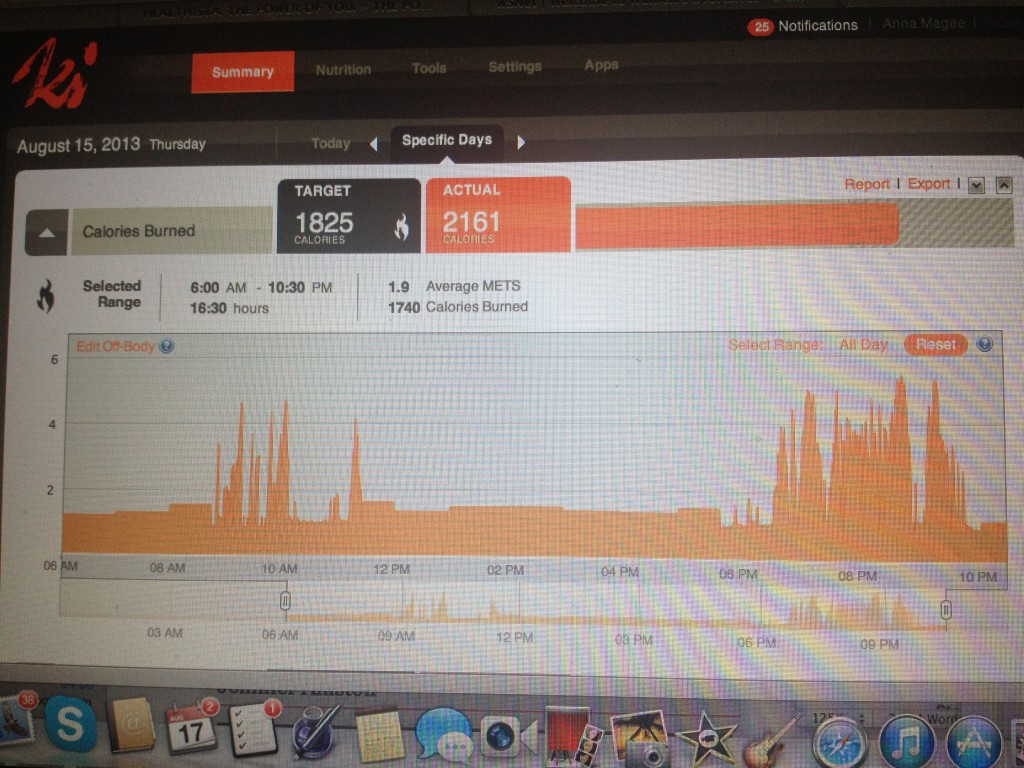When she couldn’t fit in a class for Day 16 of her 30 workouts in 30 days Anna Magee tried a different tack: the no-workout fitness scientists are going ga-ga over
Yesterday there were more of those mitigating circumstances – they’re not excuses, honest – which meant I couldn’t get to my planned workout, aerial yoga. Damn! I got a last minute write-up I had to do and then a friend was in town unexpectedly and…well, you know. So I tried another tack.
For a while now, there’s been a growing whirring of scientific murmurings about the exercise we do when we’re not working out. They’re talking basically about moving around more but because they’re scientists they’ve invented more sciencey sounding names for it such as ‘incidental exercise’ or more terrifyingly, ‘Non-Exercise Activity Thermogenesis’ – NEAT – thank God for acronyms, huh?
Well, when I realised I wouldn’t make the class that night I got the idea to test NEAT theory. First, I went running up the stairs to the sixth floor – we are on the first – each time I needed the loo. I didn’t count but between 2pm and 7pm when I left the office that must have been about five or six times up and down the stairs at the rate I drink tea.
Second, I was meeting my friend in Old Compton Street in Soho so instead of taking the Tube I walked from the office in Waterloo, across the Westminster bridge and up leicester Square to Soho. Then I walked home from the Tube station Stratford – about half an hour – on the way home at about 10.30pm (no lectures, it’s a busy road!). I clocked up over 10,000 steps on the Ki Fit which is the daily number of steps you need to clock up for weight loss, obesity researchers say. Most of us walk around 2500-5000 steps a day on average (one mile’s walk is 2000 steps roughly).
Throughout the day I also climbed the escalators from the Tube. In fact, one of the reasons I wanted to try this experiment was that the little graphy diddewops on the Ki Fit monitor reading seem to soar the most during my commute as all the stair-climbing makes for phenomenal calorie burn, it seems. This made me wonder: if someone hated working out – or didn’t have the time – could they still lose weight without formal working out? I now have proof they could.
I am wearing a Ki Fit monitor (above) for my 30 workouts in 30 days challenge which measures calories burned from all activity, not only from my workouts (though it can also indicate how many calories you burned to the minute at specific times which is how I work out the calorie burn of each workout) so it’s the perfect way to test this NEAT concept. The Ki Fit also measures steps and hours of physical activity as well.
Here’s my read out for yesterday, Friday – the day I didn’t do a formal workout – you will see a total of 2206 daily calories:
Now here is the readout for Thursday, the day I did do an hour-long and pretty tough formal workout: Frankencise. Turns out, I burned less calories that day at 2161 in total throughout the whole day than I did on Friday when I didn’t work out but moved more through the day. If there ever were proof that stairs are your friend, this is it.
Now, here is how this could lead to weight loss. If I burn on average 2200 calories a day doing NEAT, moving around more, taking the stairs and walking here and there and consume 1700 calories each of those days, I would end up with a calorie deficit of 500 calories. That’s the daily calorie deficit you need to lose weight. It takes a 3500 calorie deficit to lose one pound, that means in seven days of a 500 calorie deficit could lose a pound a week. With no formal exercise.
My little one-person experiment aside, it’s being increasingly proven that moving more through the day is better than an hour’s workout done in a day when you sit for the other nine hours you’re awake.
Earlier this year, Dr James Levin, an obesity expert at the Mayo Clinic in the US said that even going to the gym every single day couldn’t undo the damage that sitting all day did to weight and overall health.
‘A few years ago, I would have actually said to you, you know, the person who’s doing that session at the gym once a day is doing everything they need to do. But the data that are now coming up suggests that’s not the case,’ Levine told NBC News’ Natalie Morales in an interview in January this year.
‘Being sedentary for nine hours a day at the office is bad for your health whether you go home and watch television afterwards or hit the gym. It is bad whether you are morbidly obese or marathon-runner thin. It appears that what is critical and maybe even more important than going to the gym, is breaking up that sitting time.’
In 1999 Levin did some research that asked: if two people eat the same thing and do not exercise, why does one gain weight and not the other? He designed special tracking gear with sensors attached. A bit like my Ki Fit, the read out showed how much a person moves and with how much exertion and calories burned. His data showed that how much a person moves is a big dividing line between who’s obese and who’s not, not their daily formal workouts.
People who are lean, even if they don’t go to the gym, move about for two and a quarter hours a day more than overweight people, Levine found. ‘Somehow those individuals are finding the opportunities to walk to the trashcan, to walk down to accounting, to climb the stairs more, go to the coffee shop, whatever it may be.’
Where: everywhere, anywhere
How much? free
PROS It great if you’re time-pressed, walking around between work tasks clears your head, it’s free. Did we mention it’s free? CONS Walking everywhere can actually get time-consuming, next time I will listen to Radio 4 so I feel informed instead of my mindless pop playlist
Calories burned: 2206 in total – about the same, or more than workout days Calories calculated using the Ki Fit Body Monitor
READ OTHER POSTS IN THE 30 WORKOUTS IN 30 DAYS ODYSSEY
Day #3 Jennifer Aniston’s Yoga Workout
Like this article? Sign up to our newsletter to get more articles like this delivered straight to your inbox.








































































